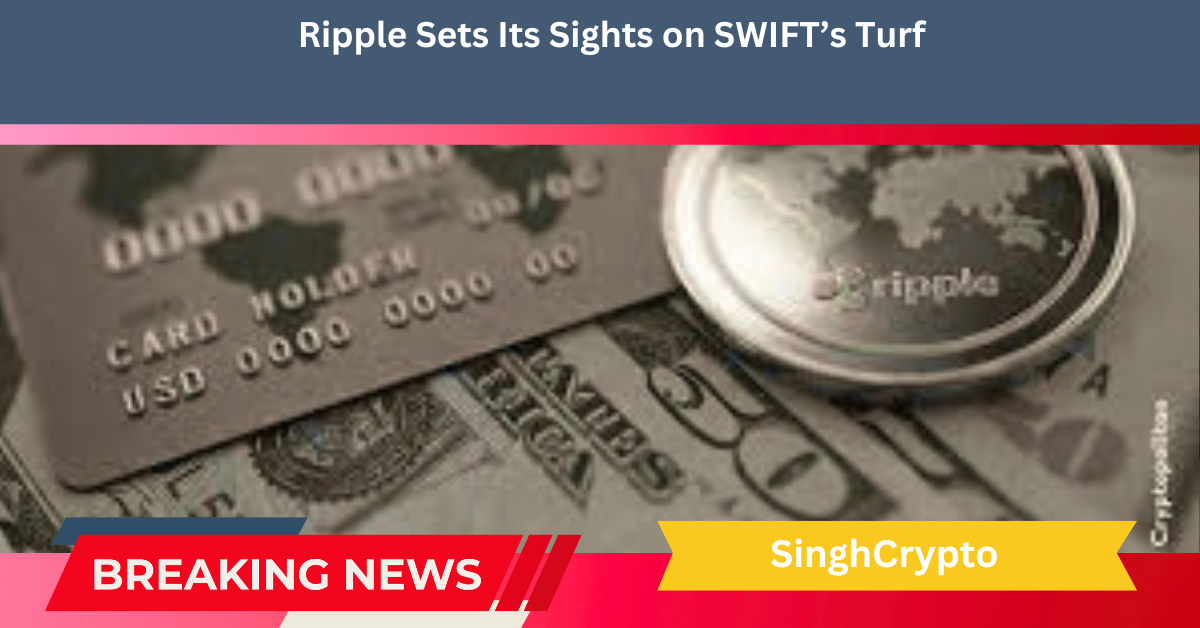Ripple, the blockchain company behind XRP, is pursuing a bold and transformative goal: capturing up to 14% of SWIFT’s cross-border payment volume within five years, a shift that could bring 1,540 financial institutions into its ecosystem.
SWIFT—the Society for Worldwide Interbank Financial Telecommunication—connects over 11,000 banks across 200 countries, enabling secure messaging but relying on slow, costly correspondent banking for actual fund settlement. Transactions can take days and carry hefty fees, especially when involving multiple intermediaries or sanctioned regions, with transfer costs often reaching into tens of dollars per transaction.
By contrast, RippleNet and its bridge currency XRP promise nearly instantaneous transfers—typically settling in 3–5 seconds—with fees measured in fractions of a cent, and no need for pre-funded correspondent accounts.
From 300 to 1,540 Financial Institutions
RippleNet already supports more than 300 banks and financial institutions—including major names such as Santander, American Express, MoneyGram, and Standard Chartered—across 40 countries. But the company isn’t satisfied: it intends to expand aggressively, targeting a base of 1,540 banks. Reaching that scale would capture approximately 14% of SWIFT’s lending network.
At APEX 2025, Ripple CEO Brad Garlinghouse emphasized that SWIFT’s strength lies in its messaging protocols, but value in cross-border payments flows from liquidity efficiency. “If you control the liquidity, that’s good for XRP,” he explained—and pointed to 2025 as the year XRP could capture that estimated 14%.
XRP as the Liquidity Backbone
At the heart of Ripple’s strategy is displacing the liquidity burden typical of cross-border bank transfers. Normally, banks must hold nostro-vostro accounts in various currencies—costly arrangements prone to inefficiency. Instead, RippleNet allows on-demand liquidity: XRP acts as a universal bridge that can be converted pre- or post-transfer as needed, removing the need for multiple reserve accounts and reducing overall capital lock-up.
This model reduces costs, speeds up transfers, and opens the door for near-instant global remittance—aligning with the demands of modern economics and consumers.
Beyond Payments—An EVM-Compatible Sidechain
Ripple isn’t just focused on high-speed transfers. It’s expanding into decentralized finance by introducing an EVM-compatible sidechain for the XRP Ledger. Developed in partnership with Peersyst, this sidechain moved from initial testnet stages to hosting over 80 projects in the XRP ecosystem.
This opens up XRP infrastructure to smart contracts, decentralized applications, yield-bearing tokenization of assets such as bonds or real estate, and even the issuance of stablecoins and other regulated digital financial products—all underpinned by Ripple’s settlement rails.
Why It Matters for Global Finance
- Velocity and Cost Efficiency
XRP can settle transactions in seconds, as opposed to SWIFT’s days-long cycles, and charges negligible fees—sharp contrast to SWIFT’s $20–50. - Capital Optimization
On-demand liquidity allows banks to keep funds idle for shorter periods, freeing capital for lending and investment rather than sitting in account balances. - Institutional Momentum
With real-world use-cases already in motion and public commitments in place, Ripple is gathering institutional confidence that legacy finance might just meet blockchain innovation head-on. - Decentralized Expansion
The EVM sidechain signals a broader ambition—Ripple is evolving from a fast-payments protocol into a decentralized platform supporting fintech applications and asset tokenization.
Obstacles Still on the Path
Despite the bold vision, challenges remain:
- SWIFT’s Entrenchment
Legacy relationships and technical inertia lend SWIFT deep-rooted stability. Banks may find it risky or complicated to abandon processes built over decades. - Regulatory Headwinds
Ongoing legal questions around XRP’s classification, plus global regulatory uncertainty, continue to cast a shadow over institutional adoption. - Technology Adoption Risks
While near-instant settlement is promising, banks require proven performance at scale. Issues such as volatility, escalations, and failover resilience remain under scrutiny.
Still, Ripple appears to be inching ahead, forging pilot projects and quietly building momentum even within conservative financial sectors.
Looking Ahead
Ripple has placed its bets confidently:
- Five-year window: Aiming for 14% of SWIFT’s daily volume, or roughly 1,540 institutions
- Hybrid strategy: Leading at the intersection of legacy finance and blockchain
- Strategic flexibility: Incorporation of smart contracts and asset tokenization via EVM sidechain
The next 12 months will prove telling. If XRP’s liquidity network matures and regulatory clarity emerges, banks will face increasing pressure to choose between sluggish, antiquated systems—or fast, efficient crypto rails with real-world payoff.
Final Word
Ripple’s vision is audacious: replace meaningful parts of SWIFT’s infrastructure, enable global financial settlements in seconds, and create a platform capable of supporting both payments and DeFi. With 300 banks already engaged—and 1,540 on the roadmap—XRP is no stranger to ambition. Its success, however, will depend on whether Ripple can convert regulation and skepticism into trust and widespread adoption.

